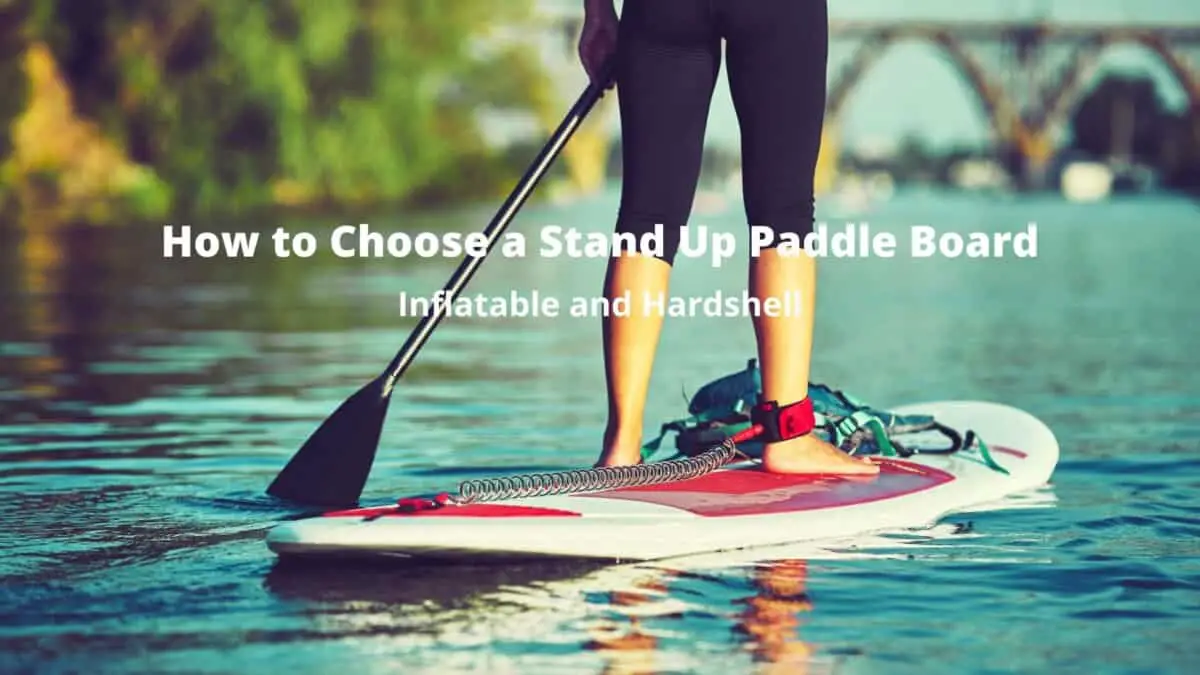Choosing a stand up paddle board, whether an inflatable or a hardshell one, is frustrating when you do not understand what features are best for your activity.
Paddle boarding is a fun summer activity that you can do alone, with your family and friends, or even with your dogs. It can also be a daily workout that help you reduce weight or tone your muscles.
To choose a paddle board, you have to know about the sizes and shapes that will suit your activity, whether it’s for all-around use, fishing, or just paddling around. Next, educate yourself about all the useful features so you can use them properly and avoid damages. Lastly, you have to know what other accessories you may need to enjoy your day out on the water.
If you are looking to buy an inflatable paddle board and are faced with too many choices or have no prior knowledge on how to select a board, we’ve got you covered. Read our article and check out our top recommendations of the best inflatable paddle boards.
Hardshell Stand Up Paddle Boards
What is a hull?
A hull is also called the body of a stand up paddle board. It is important to know about the different hull types to determine how the board will perform. Any hull type is suitable for beginners, but some differences make them better for some type of activities than others.
-
What is a planing hull?
-
- Flat and wide
- Similar to a surfboard
- Very maneuverable
- Will ride on top of the water
- Best for leisure paddling, surfing, SUP yoga, or whitewater
-
What is a displacement hull?
-
- Pointed nose or bow
- Similar to a kayak or canoe hull
- Slice through water for more efficiency
- Creates a fast and smooth ride
- Less effort to paddle for long distances and at fast speeds
- Tracks nicely and straight
- Less maneuverable
- Best for fitness paddling, SUP touring/camping, or racing
What are the pros and cons of hardshell SUPs?
Hardshell SUPs are typically made with an EPS foam core, and then wrapped with fiberglass or epoxy.
-
Pros:
– Offer the best performance
– Wider range of sizes
– Fine-tuned shapes
– Provide more stability
-
Cons:
– Heavier than inflatables
– Less compact
– Less transportable
How do volume and weight capacity affect a SUP?
-
Volume
Will give you an idea of the board’s ability to float with added weight. The higher the volume, the more weight the SUP can support.
-
Weight capacity
Will give you an idea of whether you and your gear are too heavy for the board.
What size of SUP is good for me?
Length
-
Short boards
- Under 10 feet long
- For surfing
- For kids; some are designed specifically for kids
- Most have planing hulls
- More maneuverable
-
Medium boards
- 10 to 12 feet long
- For all-around use
- For SUP yoga
- Most have planing hulls
- Displacement-hull are common
-
Long boards
- 12’6” long and above
- For fast paddling
- For long-distance touring
- Most have displacement hulls
- Faster than any sizes of boards
- Track straighter
Width
Wider boards are more stable, but they can be slower if they are too wide for you, thus making it difficult to paddle. Think about your body type, the type of paddling you do, and your abilities and level to determine the right width for you.
-
Body type
If you are small/petite, choose a narrower board to find your balance on it better. If you are a big person, it is best to choose a wider board.
-
Type of paddling
Choose a wider board if you need more storage space. For SUP yoga, a wider board, or a 31 inches wide board or more, provides better stability and space. Narrower boards are fast and more maneuverable, and thus will suit racers and surfers best.
-
Level
If you are an experienced paddler, choose a narrower and faster board. If you are a beginner, a little extra width is better to feel more secure.
Thickness
This will affect the overall volume and weight capacity, so it is important to consider this factor too. Thicker boards have more volume than thin SUPs, and a higher volume can support more weight. If you have a small body type, choose a thin SUP to keep its overall volume lower for better performance.
Fins
Fins contribute to a board’s stability and tracking. Larger fins with wide bases and long front edges will track straighter and offer more stability than smaller fins.
-
Single fins
-
- Give good tracking and minimal drag
- For flatwater paddling
-
3-fins or tri-fin setups
-
- Also called “Thruster”
- Best for straight tracking on flatwater
- Give good control in surf
- Usually all three are the same size
-
2 1 setups
-
- One large center fin with two smaller side fins
- Common setup for surfing SUPs
Accessories
-
Bungee straps/tie-downs
-
- Seen at the rear or front
- For securing essentials
-
Attachment points/mounts
-
- For securing fishing rods, seats, cameras, etc.
- Usually sold separately
-
Paddle
-
- Usually comes with the SUP
- Looks like a stretched-out canoe with a tear-drop shaped blade
-
Leash
-
- To tether the board to you
- To keep it close by if you fall off
- For safety purposes (as floatation device)
If you do not have enough time to inflate and set up a stand up paddle board, then a non-inflatable paddle board may be your best choice. If you don’t know which one you should get, check out our top recommendations of the best non-inflatable stand up paddle boards.
Inflatable Stand Up Paddle Boards
What are the pros & cons of an inflatable SUP?
-
Pros:
– Compact and easy to stow
– Easily carried with its storage bag/backpack
– Softer
– Best for travel or hiking to a lake
– Can handle whitewater better
– Comfortable for SUP yoga and SUP fitness
-
Cons:
– More delicate material
– Takes more time and effort because of the need to inflate
What size and shape of inflatable SUP is good for me?
- Longer boards for more glide and better tracking.
- Shorter boards for better maneuvering.
- Narrower boards for a faster paddle board.
- Wider boards for more stability than narrow paddle boards.
- Wide-tail paddle boards for more stability than a narrow tail.
- Narrow-tail paddle boards for more maneuverability and quick turns.
- Thicker boards to handle more weight than thinner SUPs, although an excessively thick board has disadvantages.
- Thinner boards for more stability and speed than thick paddle boards if supporting the right amount of weight.
Materials and construction
Inflatable stand up paddle boards are constructed with military-grade PVC layers covering a tight drop-stitch core, which are already durable on their own. Still, layers of PVC are applied as an outer shell for additional protection, firmness, and weight support.
Deck pad and riggings
-
Deck pad
Deck pads will make your paddling more comfortable to keep you out on the water longer. They vary in thickness, density, and textures, which will help in grip and affect how it feels underfoot.
-
Riggings
These are D-rings and bungee tie-downs. Look for a board with enough riggings to secure all the necessities you plan to bring on the board.
Fin system
The fin system impacts the versatility and performance of a SUP.
-
Configurable fin system
This fin system has removable and interchangeable fins to allow you to modify the paddle board’s performance.
Tall fins are best for those who want speed.
Large center fins with two smaller side fins offer more lateral stability.
Shorter center fins are for shallow water.
Take out the center fin and just use the two side fins for clearing obstacles and keeping your board agile. -
Permanent fin system
This system consists of three equally-sized fins that are permanently attached to the SUP. This system divides the area equally among the fins and is very handy when paddling over rocks or other debris, in shallow water.
-
Entry-level basic fin system
This is the most typical fin setup on entry-level boards. It consists of two very shallow, permanent side fins and a single, removable center fin. This allows the board to perform sufficiently in calmer conditions.
Stand up paddle boarding is one of many fun water activities that can also be a full-body workout. If you are a beginner, it is helpful to know a little bit about your gear and basic techniques before you head out on the water. Check out our paddle boarding tips for beginners to help you get started.
Accessories
Always check the quality of the accessories that come with the board.
-
Paddle
- Check its handle design.
- Check if the length is adjustable, convenient, and reliable.
- Check the shaft construction.
- Check the blade design.
- Check the materials used to make the paddle.
- Check for its overall weight.
-
Pump or inflator
Some inflatable paddle boards come with a pump and may vary in quality and ease of inflation.
-
Basic type of pump
- Consists of a single cylinder.
- Moves air into the board by pushing the handle down.
- Does not contribute anything to the board when pulling the handle up.
-
Dual-action pump system
- Moves air into the board on the upstroke and downstroke.
-
Two-cylinder pump
- Can move a lot of air at the outset.
- One cylinder needs to be disabled when the pressure increases or else pumping becomes difficult.
-
Single-cylinder dual-action pump
- Can inflate the board like a two-cylinder pump without adding bulk or weight.
-
12-volt electric inflator
- Can be powered by a car or a specifically-designed, portable power source.
- A good investment that will save you time and energy.
-
-
Leash
- An essential part of your gear kit.
- For your safety and convenience, so you won’t get separated from your board in case you fall.
- Tethers you to the board to pull it back toward you, for when you want to climb back on.
- Coiled cords for calmer or flat water. May spring back to you quickly after a fall.
- Straight leashes are more for surfing.
- Hybrid leashes are a great all-around choice.
Conclusion
Choosing the correct equipment is vital for the enjoyment of any kind of activity. When it comes to stand up paddle boarding, you have two options: a hardshell paddle board and an inflatable paddle board. The first thing that you have to do before getting your equipment is to understand these two kinds of boards. This will allow you to accurately pick the one that will work the best for you.
We have listed the features and pros and cons of both kinds of paddle boards. Use the information that we shared as a basis when you make your decision about which paddle board you’re going to get.

